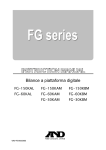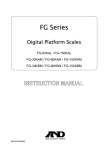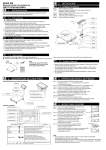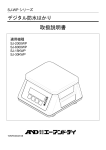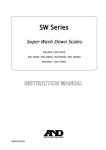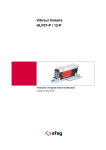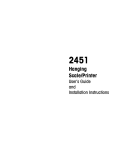Download A&D SC-150KAL Specifications
Transcript
SC/SE Series Wash Down Scales SC-30KAM / SC-60KAM / SC-150KAM / SC-60KAL / SC-150KAL SE-30KAM / SE-60KAM / SE-150KAM / SE-60KAL / SE-150KAL 1WMPD4002054 © 2010 A&D Company, Limited. All rights reserved. No part of this publication may be reproduced, transmitted, transcribed, or translated into any language in any form by any means without the written permission of A&D Company, Limited. The contents of this manual and the specifications of the instrument covered by this manual are subject to change for improvement without notice. CONTENTS 1. INTRODUCTION .................................................................................................. 2 2. FEATURES........................................................................................................... 2 3. UNPACKING ........................................................................................................ 3 4. DESCRIPTION OF EACH PART.......................................................................... 4 4-1. Display and symbols ................................................................................. 6 4-2. Switches.................................................................................................... 7 5. SETTING UP ........................................................................................................ 8 5-1. Attaching the display pole to the base ..................................................... 8 5-2. Installing the scale................................................................................... 10 5-3. Installing the batteries ..............................................................................11 6. BASIC OPERATION .......................................................................................... 12 6-1. Turning the power ON and OFF .............................................................. 12 6-2. Selecting a weighing unit......................................................................... 12 6-3. Basic weighing operation ........................................................................ 13 6-4. Weight display resolution ........................................................................ 13 7. COUNTING MODE............................................................................................. 14 8. COMPARATOR .................................................................................................. 15 9. CALIBRATION ................................................................................................... 17 9-1. Gravity acceleration correction................................................................ 17 9-2. Calibration using a weight ....................................................................... 18 9-3. Restoring to the factory setting values .................................................... 19 10. FUNCTIONS..................................................................................................... 20 10-1. Setting the parameters .......................................................................... 20 10-2. Function list ........................................................................................... 21 11. OPTIONS.......................................................................................................... 22 12. MAINTENANCE ............................................................................................... 22 12-1. Notes on maintenance .......................................................................... 22 12-2. Error codes............................................................................................ 22 13. SPECIFICATIONS............................................................................................ 23 13-1. Specifications ........................................................................................ 23 13-2. External dimensions .............................................................................. 24 GRAVITY ACCELERATION MAP .......................................................................... 26 1 1. INTRODUCTION This manual describes how the SC/SE Series Wash Down Scales work and how to get the most out of them in terms of performance. Please read this manual completely before using the scale. 2. FEATURES The SC/SE Series Wash Down Scales have the following features: Dust-tight and water-tight construction, complying with IP68. Water will not enter the scale even if immersed to a depth of 1 m for 24 hours. The weighing platform of the SC series is made of stainless steel (SUS304), and the SE series, steel. The weighing pan of both models is made of stainless steel (SUS430). As a power source, size D batteries are used. The battery life, when Alkaline batteries are used, is approximately 3,600 hours. A large LCD with a character height of 39 mm is used. Two weighing platform sizes are available. The SC-KAL and SE-KAL series have a larger weighing pan, and the SC-KAM and SE-KAM series have a smaller weighing pan. Select a model that suits your own application. Two types of weight display resolution are available, normal (1/3,000) and high (1/6,000 or 1/7,500). The counting function easily counts the number of objects of the same weight. The comparator function compares the displayed value (weight value) with the upper and lower limit values and shows the results. The optional OP-03 (SCE-03) comparator relay output can output the results as a relay signal. The optional OP-02 (SCE-02) USB interface and OP-03 (SCE-03) RS-232C serial interface can transmit the weight value to a personal computer. 2 3. UNPACKING When unpacking, check whether all of the following items are included: ●Instruction manual SC/SE Series Wash Down Scales SC-30KAM / SC-60KAM / SC-150KAM / SC-60KAL / SC-150KAL SE-30KAM / SE-60KAM / SE-150KAM / SE-60KAL / SE-150KAL ●SC-KAL / KAM series ●SE-KAL / KAM series *Pole support foot Pole support foot *Only for the SE-KAM series The cable length from the base to the display is approximately 1.5 m. 3 4. DESCRIPTION OF EACH PART ●SC-KAL / KAM series Display Display pole Option slot Spirit level Display rear side Battery cover Weighing pan Leveling foot 4 Display knob ●SE-KAL / KAM series Display Display pole Option slot Display rear side Battery cover Weighing pan Spirit level Leveling foot 5 Display knob 4-1. Display and symbols Display LCD STABLE indicator NET indicator Weighing units ZERO indicator ON/OFF switch Battery indicator ON/OFF HI,OK,LO indicators PRINT switch UNITS switch ZERO switch TARE switch Symbols Symbol Description STABLE ○ Turns on when the weight value is stable. NET ◄ Turns on when the NET weight is displayed. (The tare operation is in progress.) ZERO ◄ Turns on when the scale shows zero. iHIi OK iLOi Turns on when the comparator results are displayed. Weighing units “lb”, “oz”, “kg” and “pcs” are available. A selected unit turns on. Battery indicator The battery indicator changes as the battery capacity decreases, as shown below: New Replace the batteries. 6 4-2. Switches Switch Description ON/OFF switch Turns the power ON or OFF. When turned ON, the scale will be automatically set to zero (power-on zero). ON/OFF PRINT switch Outputs the weight value to the printer. In the setting mode, this switch is used to increase the value of the selected blinking digit by one. UNITS switch Switches the weighing unit. In the setting mode, this switch is used to shift the blinking digit to the right. ZERO switch Zeroes the scale and sets the display to zero. TARE switch Subtracts the tare (container) weight placed on the weighing pan. In the setting mode, this switch is used to store the setting value and proceed to the next step. The ZERO and TARE switches work when the weight value is stable. The ZERO switch will zero the scale if the weight value is within ±2% of the weighing capacity (kg) around the power-on zero point. The ZERO◄ indicator turns on. (ZERO operation) The TARE switch will tare the scale and subtract the weight to zero as a tare weight when the weight is a plus value. In this case the ZERO◄ and NET◄ indicators turn on. (TARE operation) When the tare is removed while the tare operation is in progress and the scale returns to the zero point, the ZERO◄ and NET◄ indicators turn on. In this case the displayed tare value will be negative. When the tare is removed while the tare operation is in progress and the ZERO operation described above is performed, the tare operation previously done is cleared and the NET◄ indicator turns off. 7 5. SETTING UP 5-1. Attaching the display pole to the base SC-KAL / KAM series Lower part of the display pole 2 1. Remove the weighing pan from the base. 2. Remove the 4 screws from the lower part of the display pole. 4 3. Pull out the cable 3. Insert the display pole under the base Base while pulling out the cable into the base and align the cable opening positions of the pole and the base. (See “3” in the illustration.) Do not pull the cable forcibly. Take care not to pinch the cable Display Base, seen between the pole and the base. pole from above 4. Align the screw holes of the pole and Cable the base. Using the 4 screws removed at step 2 to secure the display pole to the base firmly. 3. Insert 5. Lay the base on its side. Remove the 4 screws (“5” in the illustration) and remove the pole support foot. 6. Pull the excess cable out of the base. (See “6” in the illustration.) Take care not to damage the cable. And make sure the cable has no slack. 5 6 7 7. Pull the cable out to the pole side. (See “7” in the illustration.) 5 Pole support foot 8. Put the bundle of cable back into the Cable display pole. (See “8” in the illustration.) Display pole 9. Using the 4 screws removed at step 5 to secure the pole support foot to the display pole. 10. Return the base to the upright position and place the weighing pan on the base. 8 Bundle 8 9 9 SE-KAL / KAM series Lower part of the display pole 2 1. Remove the weighing pan from the base. 2. Remove the 4 screws from the lower part of the display pole. 4 Base 3. Insert the display pole under the base while pulling out the cable into the base and align the cable opening positions of the pole and the base. (See “3” in the illustration.) Do not pull the cable forcibly. Take care not to pinch the cable Base, seen between the pole and the base. from above 3. Pull out the cable 3. Insert Display pole 4. Align the screw holes of the pole and the base. Using the 4 screws removed at step 2 to secure the display pole to the base firmly. Cable 5. Turn the display knob counterclockwise to remove the display from the display pole. (“5” in the illustration) Display Cable 6 6. Pull the excess cable, from inside the base, out of the display pole. (See “6” in the illustration.) Take care not to damage the cable. And make sure the cable has no slack. 5 Display knob 5 Bundle 7. Put the bundle of cable back into the display pole. (See “7” in the illustration.) 7 8 8. Place the display on the pole and secure it using the display knob. (See “8” in the illustration.) 8 8 9. Place the weighing pan on the base. 9 7 5-2. Installing the scale 1. Select the place for installing the scale. Refer to “Precautions on installing the scale” below. 2. Adjust the level of the base, using the spirit level and leveling feet. Confirm that the bubble is in the center of the level. The SE-KAM series has an extra foot at the bottom of the display pole. Adjust this foot to touch the floor after adjusting the level of the base. Leveling foot Spirit level The size and shape depends on the scale model. 0 3. Press in on the display knob located at the lower part of the display to tilt the display to an appropriate angle, 0°, 30° or 60°. 30 Display 60 Display knob Precautions on installing the scale Consider the following conditions to get the most out of the scale. Install the scale where the temperature and relative humidity are stable and where there is no draft or vibration. Installing the scale or storing it for an extended period where the temperature and relative humidity are high and where there may be abrupt changes in temperature may cause scale failure. Install the scale on a solid and level surface. Do not install the scale in direct sunlight. Do not install the scale near heaters or air conditioners. Do not install the scale where flammable or corrosive gas is present. Do not install the scale near equipment which produces magnetic fields. Do not install the scale where there is apt to be static electricity, in a place where the relative humidity is lower than 45% RH. Insulators such as plastic are apt to be charged with static electricity. When the scale is installed for the first time, or the scale has been moved, perform calibration as described in “9. CALIBRATION”. 10 5-3. Installing the batteries Prepare six, size D (R20P or LR20) batteries. The batteries are not included with the product. The scale can be used continuously for about 3,600 hours using alkaline batteries. When appears, replace all six batteries with new ones as soon as possible. 1. Turn the battery cover on the rear of the display counterclockwise to remove it. Battery cover 2. Press on the catch in the arrow direction to release it. Take the battery compartment out in the direction of the arrow. 3. While taking care of the battery polarity, insert a battery into the battery compartment. The polarity marks are Catch shown in the battery compartment. First, insert the negative side of the battery into the compartment. Press Battery down the positive side to fit into the compartment compartment, as shown to the right. To remove the battery, reverse the procedure above. First, push in on the positive side toward to the negative side. 4. Insert six new batteries in the battery compartment as described in step 3. 5. Place the battery compartment back into the display, using the positioning tab as a guide. Secure the catch into the hole with a clicking sound. 6. Turn the battery cover clockwise to attach it. Make sure that the groove on the cover is correctly engaged and the cover is closed completely. Positioning tab Handle Battery compartment Handle Precautions on using the batteries Do not handle the batteries with wet hands. Do not allow the batteries to become wet. Take great care of the polarity of batteries. The polarity marks are shown in the battery compartment. Replace the batteries with six new ones when “lb” is displayed. Do not mix used and new batteries. It may cause damage to the batteries or product, if used. Do not mix the battery type. It may cause damage to the batteries or product. The battery life depends on the ambient temperature. Remove the batteries from the battery compartment if the scale is not to be used for a long period of time. They may leak and cause damage. Damage due to battery leakage is not covered by the warranty. 11 6. BASIC OPERATION 6-1. Turning the power ON and OFF 1. Press the ON/OFF switch to turn the power ON. All the display symbols appear and the scale waits for the weight value to become stable. After the weight value internally becomes stable, the display turns off for a moment and zero is shown with the ZERO indicator (power-on zero). If the weight value is unstable, the display shows “------”. Check if anything touches the weighing pan, or check if there is strong wind or vibration. And eliminate the cause of the error. The range for power-on zero is within ±50% of the weighing capacity (kg) around the calibrated zero point. If the power is turned ON while there is a load beyond this range, the scale shows “------”. Remove the load from the weighing pan. If the scale is to be turned ON with some item loaded, performing a zero calibration with the item loaded will allow the scale to turn ON that way. (Refer to “9. CALIBRATION”.) In this case, make sure that the total weight of the item loaded at power-on and the object to be weighed is within the weighing capacity. 2. Press the ON/OFF switch to turn the power OFF. Auto power-off function The auto power-off function automatically turns the power OFF, if zero is displayed for approximately 5 minutes. Refer to “10-2. Function list” to set “poff”. The auto power-off function has been enabled at the factory. 6-2. Selecting a weighing unit In the weighing mode, press the UNITS switch to select a weighing unit. Each time the UNITS switch is pressed, the unit changes as shown below. kg ZERO 12 lb oz pcs 6-3. Basic weighing operation 1. Press the ON/OFF switch to turn the power ON. 2. Select a weighing unit using the UNITS switch. Container 3. When the display doesn’t show zero, press the ZERO switch to set the display to zero. 4. When using a tare (container), place the container on the weighing pan, and press the TARE switch to set the display to zero. 5. Place the object to be weighed on the weighing pan or in the container, and wait for the STABLE indicator to turn on and read the value. 6. Remove the object from the weighing pan. The ZERO switch will zero the scale if the weight value is within ±2% of the weighing capacity (kg) around the power-on zero point. The ZERO◄ indicator turns on. If the weight value exceeds ±2% of the weighing capacity (kg), the ZERO switch does not work. Weighing pan Press NET ZERO Object to be weighed STABLE NET The TARE switch will tare the scale and subtract the weight to zero as a tare weight when the weight is a plus value. Weighing is possible up to the weighing capacity. When a tare is used, weighing is possible up to the weighing capacity less the tare weight value. Precautions during operation When reading or storing a value, make sure that the STABLE indicator is turned on. Do not press switches with a sharp instrument such as a pencil. Do not apply a shock load to the scale. Do not place a load on the weighing pan that exceeds the weighing capacity. Keep the scale free from foreign objects. Calibrate the scale periodically to keep weighing accuracy. (Refer to “9. CALIBRATION”.) 6-4. Weight display resolution The weight display resolution is a ratio of the minimum display to the weighing capacity. The SC/SE series has two types of weight display resolution, normal and high. Normal: High: 1/3,000 1/6,000 or 1/7,500 (depending on the weighing capacity) The factory setting is the high resolution. Select the resolution that suits your own application by the function setting “r5eo”. For details about the minimum display and the weighing capacity, refer to “13-1. Specifications”. In the counting mode, the scale works with the high resolution regardless of the weight display resolution selected by the function setting “r5eo”. 13 7. COUNTING MODE Determines a unit weight (the weight of one piece) from the known pieces of samples, and calculates how many pieces are on the weighing pan using the unit weight. The unit weight is maintained even if the power is turned OFF. 1. Press the UNITS Press switch to select “pcs”. (“pcs” = pieces) ZERO 2. Press and hold the UNITS switch to enter the sample unit weight storing mode. The numerical value on the left indicates the number of samples. Press and hold Number of samples ZERO Press 3. To change the number of samples, press the PRINT switch. It may be set to 5, l0, 20, 50 or l00. 4. If necessary, place a container on the weighing pan, and press the TARE1 switch. Confirm that the right side of the number of samples shows zero. Container Weighing pan Press 5. Place the correct number of samples on the weighing pan or in the container. ZERO Samples 6. Confirm that the STABLE indicator is turned on. Press the UNITS switch to calculate and store the unit weight. Remove the samples. The scale is set to count objects with this unit weight. STABLE The total weight of samples should be more than shown below, regardless of the number of samples. Weighing capacity of 30 kg: 0.05 kg Weighing capacity of 60 kg: 0.1 kg Weighing capacity of 150 kg: 0.2 kg If not, the display shows “lo ut” and returns to the display of step 5. Increase the number of samples (step 3) and try again. 7. Place the objects to be counted on the weighing pan. 14 Press Confirm zero 8. COMPARATOR Compares the weight value with the upper and lower limit values and shows the results of the comparison by HI OK LO on the display. The formula to compare is as follows: 1LO < Lower limit value ≤ OK ≤ Upper limit value < HI Select comparison conditions that suit your own application. (Refer to “Comparator mode: Cp” in “10-2. Function list”.) 0: No comparison (comparator function disabled). 1: To compare all data. 2: To compare all stable data. 3: To compare all data which are more than +4d or less than -4d. 4: To compare stable data which are more than +4d or less than -4d. 5: To compare all data which are more than +4d. 6: To compare stable data which are more than +4d. d = minimum display (Refer to “13-1. Specifications”.) Also in the counting mode, “d” is equal to the minimum display of kg mode. The upper and lower limit values are maintained even if the power is turned OFF. The upper and lower limit values are common to the weighing and counting mode. Ignore the decimal point when setting the upper limit or lower limit value. For example, when the weighing capacity is 30 kg and the setting value is “001000”: Display mode Normal resolution kg High resolution kg Normal resolution lb High resolution lb Normal resolution oz High resolution oz Counting mode Limit value 10.00 kg 1.000 kg 10.00 lb 10.00 lb 100.0 oz 100.0 oz 1000 pcs 15 Capacity / Minimum display 30.00 kg / 0.01 kg 30.000 kg / 0.005 kg 66.00 lb / 0.02 lb 66.00 lb / 0.01 lb 1050.0 oz / 0.5 oz 1050.0 oz / 0.2 oz Entering the upper and lower limit values 1. Press the UNITS switch to select a weighing unit, ”kg”, ”lb” or ”oz” 2. Press and hold the UNITS switch to enter the upper limit setting mode. Press Press and hold 3. Enter the upper limit value using the following switches. UNITS To shift the blinking digit to the right. PRINT To increase the value of the blinking digit by one. The minus sign can be selected as a blinking digit after the least significant digit. The PRINT switch alternates the minus sign on and off. The blinking “-” shows minus and no sign is plus. 4. After setting all of the digits, press the TARE switch. Then, the upper limit value is stored and the display goes to the lower limit setting mode. 5. Set the lower limit value in the same way as the upper limit value setting procedure, and press the TARE switch to return to the weighing mode. 16 Press Press Press Set the lower limit value 9. CALIBRATION Adjusts the scale for accurate weighing. Calibrate the scale in the following cases. When the scale is first installed. When the scale has been moved. When the ambient environment has changed. For regular calibration. 9-1. Gravity acceleration correction When the scale is first used or has been moved to another location, it should be calibrated using a calibration weight. But if a calibration weight is not available, the gravity acceleration correction will compensate the scale. Change the gravity acceleration value stored in the scale to the value of the area where the scale will be used. Refer to the gravity acceleration map at the end of this manual. Note Gravity acceleration correction is not required when the scale will be calibrated using a calibration weight at the place where it is to be used. Make sure that the scale is in the weighing mode (displaying “kg”, “lb”, “oz” or “pcs”). 1. Press and hold the TARE switch until the gravity acceleration value (in this example: 9.7985) appears, and release the switch. 2. Press and hold the UNITS the value starts to blink. . switch until Press and hold (more than 4 seconds) Release Press and hold 3. Change the displayed value using the following switches. UNITS PRINT To shift the blinking digit to the right. Press To increase the value of the blinking digit by one. 4. Press the TARE switch. The setting value is stored and “end” is displayed. 5. When calibration using a calibration weight is to be performed, go to step 3 of “9-2. Calibration using a weight”. To finish the setting procedure, turn the power OFF. 17 Press 9-2. Calibration using a weight Prepare a weight, preferably a weight with the same value as the weighing capacity of the scale to be calibrated. Note that the calibration weight value can be set by 10 kg/lb. 1. Turn the power ON and warm up the scale for at least half an hour. Change the function setting “poff” or place something on the weighing pan to disable the auto power-off function. Make sure that the scale is in the weighing mode (displaying “kg”, “lb”, “oz” or “pcs”). Press and hold (more than 4 seconds) 2. Press and hold the TARE switch until the gravity acceleration value appears, and release the switch. 3. Press the UNITS switch and display “Cal”. Release Press 4. Press and hold the UNITS switch until “Cal 0” is displayed. Confirm that nothing is placed on the weighing pan and wait for the STABLE indicator to turn on. 5. Press the TARE switch. The scale calibrates the zero point and displays the value of the calibration weight (SPAN calibration). Press and hold The calibration weight value is equal to the weighing capacity. (factory setting) Press If SPAN calibration is not to be performed, turn the power OFF to exit from the calibration procedure. 6. To calibrate with a weight different from the weighing capacity, change the displayed value using the following switches. UNITS To shift the digit that is blinking (unit of measure included) to the right. PRINT To increase the value of the blinking digit by one or to switch the unit between kg and lb. 7. Place the calibration weight with the same value as displayed on the weighing pan, and wait for the STABLE indicator to turn on. Press Calibration weight Weighing pan 8. Press the TARE switch. The scale calibrates SPAN and “end” is displayed. Remove the weight from the weighing pan, and turn the power OFF. Note If the scale will be moved to another location, set the gravity acceleration value for the new location and calibrate the scale according to the procedure above. Refer to the previous section to set the gravity acceleration value. 18 Press 9-3. Restoring to the factory setting values If the gravity acceleration value or calibration weight value is changed unintentionally, restore those values to the factory setting values, as follows. Make sure that the scale is in the weighing mode (displaying “kg”, “lb”, “oz” or “pcs”). 1. Press and hold the TARE switch until the gravity acceleration value appears, and release the switch. 2. Press the UNITS display “ClrC” . . switch twice and 3. Press and hold the UNITS “ClrCno” appears blinking. Press and hold (more than 4 seconds) Release Press twice switch until Press and hold 4. Press the PRINT switch. “ClrCno” changes to “ClrCgo”. Press 5. When “ClrCgo” is displayed, press the TARE switch. The factory setting values are restored and “end” is displayed. To finish the restoring procedure, turn the power OFF. 19 Press 10. FUNCTIONS The scale has function settings to specify the scale performance. The parameters set in the function settings are maintained even if the power is turned OFF. Parameter Item 10-1. Setting the parameters While holding down, 1. Turn the power OFF. 2. Press and hold the TARE switch and press the ON/OFF switch to turn the power ON. The software version is displayed. “∗∗∗” indicates the software version number. 3. Press the UNITS switch to display the item. press ON/OFF Press 4. Change the item or parameter using the following switches. UNITS To display the next item. PRINT To increase the value of the blinking digit by one (to change the parameter). Press When the parameter is changed, the STABLE indicator turns off. 5. Press the TARE switch to store the setting value. After “end”, the scale returns to the weighing mode. To restore the function settings to the factory setting values When “Clrfno” is displayed, press the PRINT switch to change to “Clrfgo”. Then, press the TARE switch. The When changed Press Press function settings are restored to the factory setting values. After “end”, the scale returns to the weighing mode. Press 20 10-2. Function list Item Auto power-off function Parameter 0 Auto power-off disabled poff 1 Auto power-off enabled Weight display resolution 0 Description Normal (1/3,000) r5eo 1 High (1/6,000 or 1/7,500) Serial interface Baud rate 0 1 2 2400 bps 4800 bps 9600 bps Stream mode Command mode bp5 Serial interface Data output mode prt 0 1 Command mode only 2 Print switch mode 3 4 Serial interface Response aCk 0 1 Comparator mode 0 1 Cp 2 3 4 5 6 sStability 0 Response speed 1 Cond 2 Zero tracking 0 1 trc Decimal point 0 Changes “d”, minimum display Command mode Auto-print mode +/- data Command mode Auto-print mode + data Command mode No reply except “Q” command Reply to commands Comparator disabled Compares all data Compares all stable data Compares data of > +4d or < -4d Compares stable data of > +4d or < -4d Compares data of > +5d Compares stable data of > +5d Weak / fast response Normal / normal response Strong / slow response Zero tracking function disabled Comparison conditions d = minimum display Tracks the zero drift Zero tracking function enabled Selects a point type. Dot (.) dp 1 Comma (,) Initialization no Initialization disabled Clrf Turns the power OFF automatically Restores the function settings to the factory setting values. Initialization enabled go Factory setting d = minimum display, the minimum mass that can be weighed Even the counting mode uses “d” for judgment. 21 decimal 11. OPTIONS The following options are available for the SC/SE series: OP-02 (SCE-02) OP-03 (SCE-03) USB interface RS-232C serial interface and Comparator relay output Note When an option is installed, the dust-tight and water-tight performance of the scale will be degraded. For details, refer to the instruction manual for the options. 12. MAINTENANCE 12-1. Notes on maintenance Do not disassemble the scale. Contact your local A&D dealer if the scale needs service or repair. Use the original packaging for transportation. Do not use organic solvents to clean the scale. Use a warm lint free cloth dampened with a mild detergent. Calibrate the scale periodically to keep weighing accuracy. 12-2. Error codes Overload error Indicates that an object beyond the weighing capacity has been placed on the weighing pan. Remove the object from the weighing pan. Underload error Indicates that the weight sensor receives strong force upward. Check if the weighing pan is touching anything or if there is anything in the base. There is a possibility that the weight sensor or internal circuit may have a failure. Unit weight error Indicates that the sample weight is too light to set the unit weight in the counting mode. Increase the number of samples. Low battery Indicates that the batteries are depleted. Replace them with new batteries. Other The internal circuit may have a failure. (∗ indicates an error number.) If the error persists or other errors occur, contact your local A&D dealer. 22 13. SPECIFICATIONS 13-1. Specifications Materials SC series: SE series: MODEL Weighing capacity (kg) Minimum display “d” (kg) Weighing capacity (lb) Minimum display “d” (lb) Weighing capacity (oz) Minimum display “d” (oz) Number of samples Maximum count Minimum unit weight Repeatability (Std. deviation) Linearity Sensitivity drift Display Display update Operating conditions Power supply Battery operating Weighing pan size Dimensions Mass (approximately) Calibration weight (factory setting) Weighing platform Stainless steel (SUS304) Steel Weighing pan Stainless steel (SUS304) Stainless steel (SUS430) SC-30KAM SE-30KAM SC-60KAM SE-60KAM SC-150KAM SE-150KAM SC-60KAL SE-60KAL SC-150KAL SE-150KAL 30 60 150 60 150 0.01 0.005 * 0.02 0.01 * 0.05 0.02 * 0.02 0.01 * 0.05 0.02 * 130 330 130 330 0.02 0.01 * 0.05 0.02 * 0.1 0.05 * 0.05 0.02 * 0.1 0.05 * 1050 2100 66 5200 2100 5200 0.5 0.2 * 1 2 1 2 0.5 * 1* 0.5 * 1* 5 (can be changed to 10, 20, 50 or 100) pieces 60,000 pcs 60,000 pcs 75,000 pcs 60,000 pcs 75,000 pcs 0.0005 kg 0.001 kg 0.002 kg 0.001 kg 0.002 kg 0.005 kg 0.01 kg 0.02 kg 0.01 kg 0.02 kg ±0.01 kg ±0.02 kg ±0.05 kg ±0.02 kg ±0.05 kg ±20 ppm / °C (5°C to 35°C / 41°F to 95°F) 7 segment LCD (character height 39 mm) 10 times per second -10°C to 40°C / 14°F to 104°F, 85% R.H. or less (non-condensing) Size D (R20P / LR20) batteries x 6 Approximately 3,600 hours using alkaline batteries 300 x 380 mm / 11.8 x 15.0 in. 390 x 530 mm / 15.4 x 20.9 in. SC-KAM: 300(W) x 543(D) x 717(H) mm 11.8(W) x 21.4(D) x 28.2(H) in. SE-KAM: 300(W) x 582(D) x 722(H) mm 11.8(W) x 22.9(D) x 28.4(H) in. SC-KAL: 390(W) x 688(D) x 717(H) mm SC-KAL: 15.4(W) x 27.1(D) x 28.2(H) in. SE-KAL: 390(W) x 732(D) x 722(H) mm SE-KAL: 15.4(W) x 28.8(D) x 28.4(H) in. SC-KAM: 12 kg SE-KAM: 12 kg SC-KAL: 16 kg SE-KAL: 16 kg 30 kg 60 lb 60 kg 120 lb 150 kg 300 lb 60 kg 120 lb * Factory setting The cable length from the base to the display is approximately 1.5 m. 23 150 kg 300 lb 13-2. External dimensions ●SC-30KAM / SC-60KAM / SC-150KAM 163 380 717 60 38.1 117 300 173 300 220 ●SC-60KAL / SC-150KAL 158 530 717 60 38.1 123 390 173 440 300 Unit: mm 24 ●SE-30KAM / SE-60KAM / SE-150KAM 60 380 722 202 40 118 300 202 220 300 ●SE-60KAL / SE-150KAL 202 530 722 60 40 128 390 440 300 Unit: mm 25 GRAVITY ACCELERATION MAP Values of gravity at various locations Amsterdam Athens Auckland NZ Bangkok Birmingham Brussels Buenos Aires Calcutta Cape Town Chicago Copenhagen Cyprus Djakarta Frankfurt Glasgow Havana Helsinki Kuwait Lisbon London (Greenwich) Los Angeles Madrid 9.813 m/s2 9.807 m/s2 9.799 m/s2 9.783 m/s2 9.813 m/s2 9.811 m/s2 9.797 m/s2 9.788 m/s2 9.796 m/s2 9.803 m/s2 9.815 m/s2 9.797 m/s2 9.781 m/s2 9.810 m/s2 9.816 m/s2 9.788 m/s2 9.819 m/s2 9.793 m/s2 9.801 m/s2 9.812 m/s2 9.796 m/s2 9.800 m/s2 Manila Melbourne Mexico City Milan New York Oslo Ottawa Paris Rio de Janeiro Rome San Francisco Singapore Stockholm Sydney Taichung Tainan Taipei Tokyo Vancouver, BC Washington DC Wellington NZ Zurich 26 9.784 m/s2 9.800 m/s2 9.779 m/s2 9.806 m/s2 9.802 m/s2 9.819 m/s2 9.806 m/s2 9.809 m/s2 9.788 m/s2 9.803 m/s2 9.800 m/s2 9.781 m/s2 9.818 m/s2 9.797 m/s2 9.789 m/s2 9.788 m/s2 9.790 m/s2 9.798 m/s2 9.809 m/s2 9.801 m/s2 9.803 m/s2 9.807 m/s2 World map 27





























